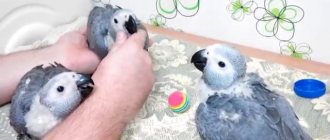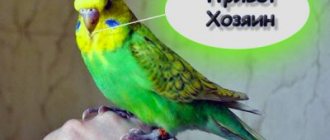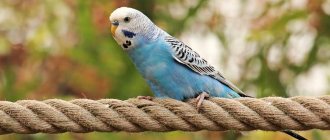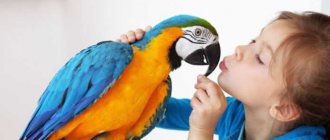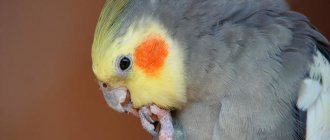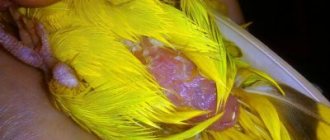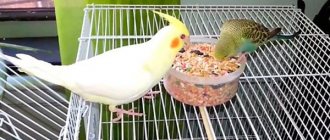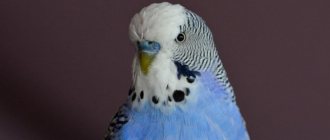Here we discuss the methodology of how to teach a parrot to speak, as well as 7 key factors that influence the effectiveness of teaching conversation. It is worth paying special attention to these factors, because... They are the ones who make a wonderful teacher out of one person, and a very bad one out of another. The advantages of the presented approach are that even if you do not teach conversation, the classes will help to establish contact and form a good relationship with the parrot.
A number of owners have a question about whether it is possible to teach a parrot to speak at all. It depends on the type of bird, its personality and the owner's ability to act as a teacher. The most popular talking feathered pets are wavy, gray, necklace, cockatoos, amazons and macaws. Some species, such as cockatiels or rosellas, are capable of learning one or two words in rare cases, but they are good at reproducing various sounds and melodies.
The earlier the better
The speed and success of the learning process depends on several factors.
- Age. The younger the bird, the easier it is to train. It is recommended to start training small parrots (like budgies and cockatiels) at the age of 1-2 months. If the bird is already an adult, teaching it to speak will be more difficult.
- Paula. Males are easier to train than females, especially budgies. Sometimes you can even hear the opinion that females are not trainable at all, but this is not entirely true, the pedagogical process will simply be longer. By the way, according to experts, if females start talking, they pronounce the words more clearly than males.
First of all, establish a trusting relationship with the bird. - Factor of “psychological comfort”. The parrot should have confidence in you. That is, do not express concern when you approach the cage, take food from your hands without fear, sit on your hand or shoulder, show interest in interacting with you (and not only in receiving food).
- Favorable conditions. First of all, this is the absence of distractions during the lesson. Make sure that there is no noise or fuss around that will occupy the parrot’s attention. If you have several birds, it is better to isolate the “student” from his fellow birds for the duration of the lessons.
Important! Birds perceive high-pitched voices better, so they quickly remember and reproduce words spoken by women or children.
Budgerigars: which ones are predisposed to learning
Budgerigars are capable birds, and they can all talk. However, it is worth knowing that some individuals are very difficult to train. Others, on the contrary, will be able to repeat words earlier than their counterparts.
So, if you want to hear your budgie talk, get a male. Boys find learning easier than girls. Females are also able to talk, but the process can take a long time. The advantage is that they pronounce words more clearly.
Photo: pixabay.com: UGC
For a parrot to speak, it is optimal if it lives alone. Pets that are in a pair are busy with each other and therefore rarely communicate in human language. But if you add a female to a male who has already mastered speech, he can teach her to speak too. Although such cases are also rare.
Where to start
It is important to immediately understand that the bird does not understand the meaning of the words. It can only imitate a certain sequence of sounds of human speech, which is why systematic repeated repetition is so important. Do not give your parrot too difficult tasks at once, such as learning a long phrase. Start with 2-3 short words. Alternate them. Keep in mind that the parrot may simply not like some words, and therefore he will not repeat them.
Advice. Parrots find it easier to learn words that contain the sounds “r”, “p”, “k”, “t”. "sh", "ch". It is with these words that it is better to start learning. The simplest example is the words “hello”, “guard”.
The main thing in the learning process is systematicity. If you only work with your parrot “when the mood strikes,” it won’t do any good.
- Classes should be daily.
- Several lessons are taught per day (on average 2-3), preferably at the same agreed time.
- One lesson can last from 10 to 40 minutes, as long as your pet’s attention span is sufficient. Once he loses interest, the lesson is over.
Do not forget to repeat the material you have covered - birds tend to forget what they have learned without practice, just like people.
To teach your pet to speak, exercise regularly.
Budgerigar: at what age is it easier to teach to speak?
If you are wondering how to teach a parrot to speak, then you are probably thinking not only about the bird’s gender, but also about its age. And it is right. Of course, a pet's ability to speak depends on its talent. But age is also important: it is easier to teach a young male to communicate than an adult.
When should you start speech lessons? Feel free to work with the bird if a little more than a month has passed since its birth. You can start training in the near future. If the bird is more than five months old, it will be difficult for her to master speech.
Photo: pixabay.com: UGC
Please note that adult females are practically resistant to verbal training. It is possible to work with older males, but it will not be easy.
Of course, it is difficult to determine the age of a parrot by eye. We advise you to pay attention to the head: the bird’s first molt begins around three months. Therefore, if a pet’s feathers are wavy in color right up to its beak, it is still a chick. The babies also have a paler color and a short tail, black eyes, and smooth paws.
Set up a contact
During training, do not just mumble a phrase in the presence of a parrot, but contact him, try to build interaction.
- Use emotions. Emotionally charged phrases will be easier for your pet to remember. For example, say your parrot's name affectionately.
- Choose a moment when the bird is in a good mood and ready to make contact. It’s a bad time if the parrot is hungry, excited, doing some of his own business (cleaning feathers, being carried away by a toy or having fun with his fellow tribesmen).
- Be sure to reward the bird with something tasty after exercise. And even more so, encourage success.
As practice shows, birds that live alone, without fellow tribesmen, learn faster, and therefore get used to communicating with humans. But sometimes another parrot, already speaking, can be an assistant in training. If you place a bird that is not yet talking, the new neighbor may soon begin to imitate the “babbler.”
Attention! The bird learns words that you say frequently and emotionally especially quickly, so refrain from frequently repeating curses and other phrases that you would not like to hear from your feathered pet.
Does a parrot's gender affect its ability to speak?
There is a statement that female parrots learn to speak less well than male parrots. There is some truth in this, since girls' speaking skills are a bit limited.
But if you set yourself a goal, you can teach a girl to speak a parrot, then the spoken words will be much clearer than those of boys.
There are no particular differences in training feathered boys and girls, you just need to spend much more time teaching girls to speak.
Which parrots talk the best?
- Jaco is a smart, fairly calm pet. If a bird is taught to speak intensively and efficiently, the bird will become a well-mannered friend with excellent conversational abilities. They have a penchant for self-learning.
- Amazon, easy to learn and a talker from God. Some of its individuals are capable of learning more than 100 words. If you were looking for a bird with such data, then this species would be an excellent option.
- The wavy pet is a talkative bird, capable of remembering and speaking individual words. The quality of reproduction is not very good, but if the bird is trained more often, this will change.
The variety of species is undoubtedly very great, but there are still absolute record holders, such as Jaco, this is the only parrot that is easiest to teach to speak. Birds are very intelligent; they remember words, phrases, phrases and even entire sentences faster than others. Voices, sounds, and music are perfectly and accurately portrayed. Well-trained Jacos can not only pronounce learned words and phrases, but also carry on a conversation.
Let's automate the process?
Some resourceful bird owners try using a tape recorder for training. It seems so convenient - I wrote down a phrase once and played it for at least half an hour, at least half a day. And you don’t need to waste your own time and nerves on monotonous “droning.” Mind your own business, and the parrot sits and learns... Simple and brilliant? Not really.
Firstly, a parrot, even having memorized phrases behind a tape-recorder voice, may refuse to talk “in public.” To avoid having to listen to bird speech exclusively from behind the doors, at least stay in the room during the audio lesson.
A parrot perceives a tape recording worse than live human speech.
Secondly, the scarecrow will perceive a tape recording that plays for a long time simply as background noise, and training will not take place.
Thirdly, if you want your parrot to say a word or phrase in response to some external action (say, say “hello” when you enter the room, “handsome” when he sees himself in the mirror), the tape recorder will not do anything will help. Let us remind you once again that the bird does not understand the meaning of words. It can produce the “necessary” combinations of sounds only at the level of a reflex to a certain situation, and only you can form such a reflex. For example, every time you show your parrot a mirror, repeat “handsome”, and he will associate this word with your action.
If you still want to use tape recordings, do it not at the very beginning of training, but when the bird begins to pronounce at least one word.
Talking fauna
The ability to translate one's abstract ideas into sound waves of a certain frequency, called speech, is one of the characteristics of a person. Aristotle wrote about this. Science does not know of any animal species, with the exception of Homo sapiens, that could speak intelligently. As a rule, animals can communicate information through body movements or whistles, but this cannot be called speech.
However, there are certain representatives of the fauna that can quite accurately reproduce individual human words without realizing their semantic load. Among them:
- Parrots (usually large in size);
- Starlings;
- There are known cases of crows being taught some words in Russian zoos;
- Singing birds (eg nightingale);
- Anthropomorphic monkeys;
- Some domesticated animals pronounce sounds that can be taken as words by different peoples in different languages. For example, the ability to “speak” has been observed in dogs and cats, as well as in livestock. However, this belongs to the realm of fantasy of each individual person, who can attribute anything to his pet;
- In the 60s of the 20th century, a large-scale study was carried out to detect the speech of dolphins. But the enterprise was not particularly successful. Modern scientific thought does not consider the communication of these aquatic mammals to be speech.
When will he speak?
How long does it take to train a bird? Much here depends, of course, on her individual abilities - some birds have an excellent gift for imitation. A “gifted” parrot can begin to try to pronounce individual sounds of human speech already in the first day. But clear pronunciation of syllables, words, and even more so phrases require a lot of practice. Parrots master the first word on average in a week to a month.
Remember that learned words must be repeated so that the parrot does not forget them
They remember memorized words for a long time, although without practice, clarity of pronunciation may be lost over time, syllables may become confused (for example, a bird can put two words into one, or even replace parts of words with chirps).
So getting your bird to talk is quite possible, and not even too difficult. In addition to the usual “Goshi or Kesha” and “hello-bye,” come up with a few funny phrases that you will teach your parrot. For example, the famous cartoon “Tahiti, Tahiti! They feed us well here too.” Then an uninterrupted source of positivity will appear in your home. And no matter how successful the day was, you can be sure that when you come home, you will certainly smile.
Common Mistakes
It is important in the training process not to make common mistakes that can frighten the bird, and in some cases lead to the fact that it will never copy speech.
Such errors include:
- Raising your voice.
- Attempts to forcefully place a bird on a shoulder or arm.
- Conducting a lesson in an irritated state.
- Lessons are too long.
- The desire to immediately teach different words and phrases.
- Unsystematic approach to the learning process.
- The presence of strangers in the room.
- Voices, music, TV on, etc. in the apartment during class.
- Attempts to train two or more chicks at once.
- Conducting lessons by different people.
It is also prohibited, once the learning process has begun, to use obscene words around parrots. The bird can learn them and begin to repeat them.
